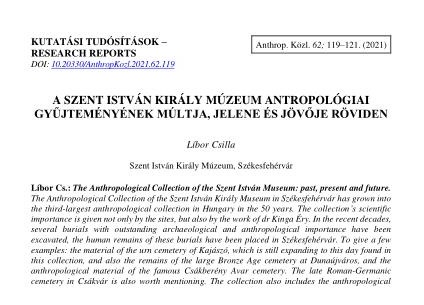A Szent István Király Múzeum antropológiai gyűjteményének múltja, jelene és jövője röviden
Absztrakt
The Anthropological Collection of the Szent István Király Museum in Székesfehérvár has grown into the third-largest anthropological collection in Hungary in the 50 years. The collection’s scientific importance is given not only by the sites, but also by the work of dr Kinga Éry. In the recent decades, several burials with outstanding archaeological and anthropological importance have been excavated, the human remains of these burials have been placed in Székesfehérvár. To give a few examples: the material of the urn cemetery of Kajászó, which is still expanding to this day found in this collection, and also the remains of the large Bronze Age cemetery at Dunaújváros, and the anthropological material of the famous Csákberény Avar cemetery. The late Roman-Germanic cemetery in Csákvár is also worth mentioning. The collection also includes the anthropological materials of the cemeteries found in the Tác/Gorsium area, which includes more than 1000 graves. After a short break, the scientific processing received a new impetus, and the anthropological material of Fejér County can be introduced to more and more forums.
Hivatkozások
Éry, K., Marcsik, A., Rácz, P. (2020): Csákvár késő római népességének embertani vázlata. Folia Anthropologica, 16: 5–28.
Líbor, Cs., Kiss, K., Szeniczey, T., Mateovics-László, O., Szücsi, F. (2021): Paleopathological analysis of skeletal remains from Avar Period and Hungarian Conquest Period cemeteries of Bodajk from Hungary. 7th Portuguese Conference on Paleopathology, September 24–25, 2021.
Líbor, Cs., Szeniczey, T., Kiss, K. (2021): Bodajk avar kori és 10. századi temetőinek bioarchaeológiai elemzése. In: Szücsi, F. (Szerk.) Avarok és magyarok Bodajkon. 6–10. századi temetkezések komplex elemzése. Székesfehérvár.




